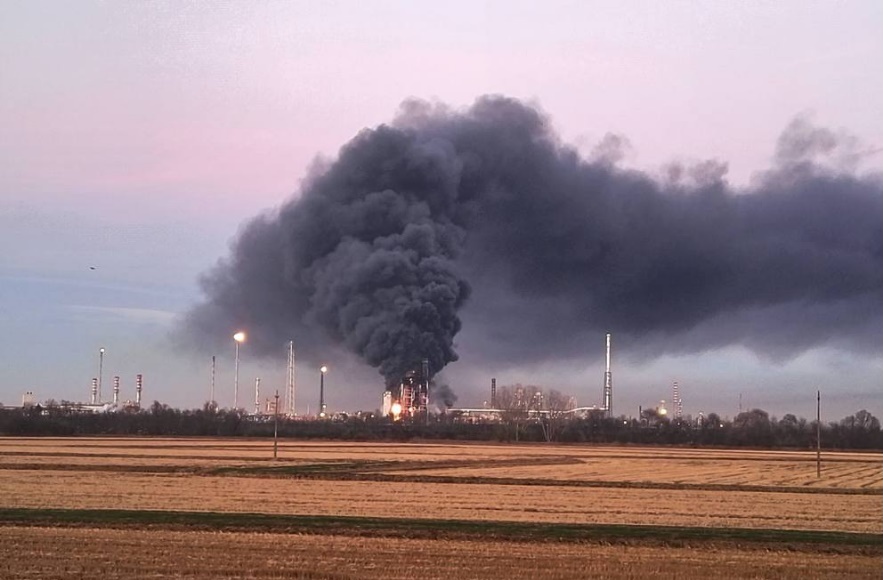
On 1st December, 2016, a fire started inside an oil refinery in Sannazzaro de’ Burgundi, in Northern Italy. The witnesses saw “a ball of fire” tens of meters tall. Right after the incident, units from Fire Fighters, Police and internal teams of the refinery arrived there to manage it. The refinery also activated the internal Emergency Plan.
The danger for Sannazzaro: toxic cloud
In case of fire in a refinery, other than the fire itself, danger has a specific name: toxic cloud. The risk, in this case, was that the fire would have emitted a cloud containing harmful materials, which would have been at the mercy of winds and capable of put the population in danger.
No real danger
After the surveys and the evaluations of Ats (the Agency for the protection of health), Arpa (the regional Agency for environmental protection) and Eni (the company that owns the refinery), the alarm was withdrawn. The cloud did not contain dangerous materials, and the wind pushed them vertically, avoiding that the falling of particulates to the terrain. In the next morning, Eni communicated the all-clear with a note saying that “there are no signs of significant air pollution in the area”. Arpa, thanks to the data collected by its teams, observed that there were no “significant increases of the pollutants”.
Alerting the population
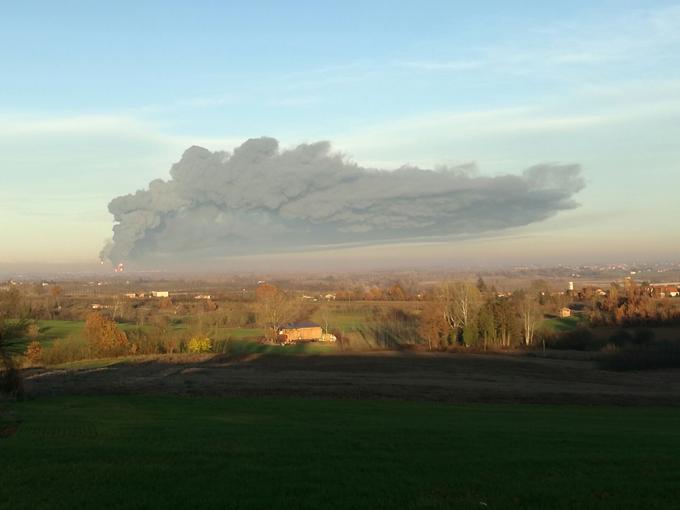
According to the municipal assessor to the civil protection, Roberto Fuggini, this has been “one of the biggest incidents in this plant”. The risk was clear: a dark cloud was coming out of the refinery, getting bigger, and the first thing to do was to not expose the population to its possible harmful effects. The Mayor had to take the right actions to mitigate the impact of the cloud and to inform the citizens rapidly.
How the Mayor managed the communication:
The response of the Mayor has been prompt. The Municipality closed the roads near the refinery and alerted the population through SMS, messages on Facebook and on the municipal website, as well as through megaphones. The message said to remain at home or inside a building. Therefore, the communication was based on channels that reach the citizens personally (website, Facebook, SMS), and on “traditional” public channels such as megaphones. The Municipality has been particularly active through its IT channels: the website and the Facebook page promptly reported notes from the Mayor. The notes included the information about the fire, the instruction to the population (to stay inside a building), the communication of the closure of the schools and every update on the status of the pollution surveys.
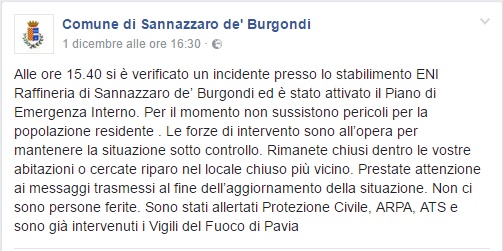
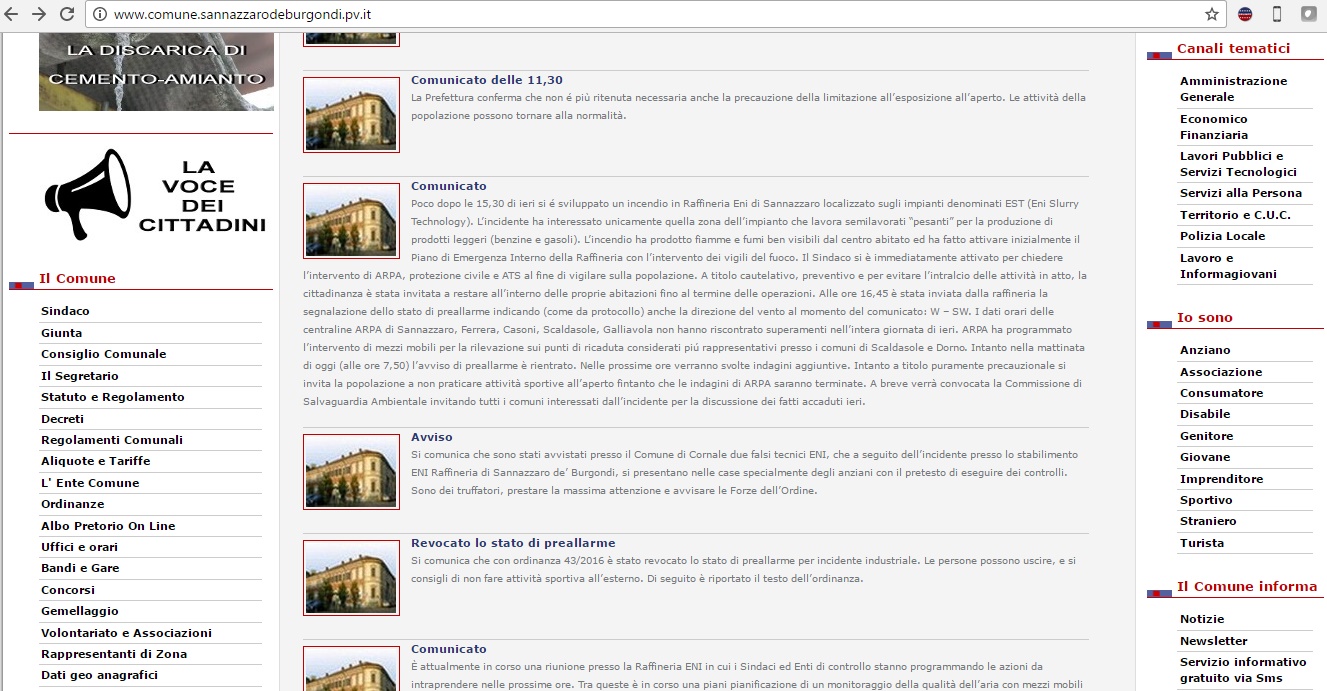
Moreover, the Mayor activated the municipal SMS service. This service, created in 2014, enables Sannazzaro to send an SMS to the citizens registered to the service (not all the population), which includes information and instructions. The SMS service can be activated once the Municipal Emergency Plan has been activated too.

The Municipality has also used megaphones. This door-to-door system can be useful in towns like Sannazzaro: not too big (less than 6000 residents) and with short buildings, without big apartment blocks common in big cities. The megaphones have been useful for reaching some of those citizens which have not an Internet connection (or which do not use it, e.g. elderly), and are not registered to the SMS system.
Were those channels enough?
The Mayor managed the event in an appropriate way, keeping in consideration the available means and the fact that the potential threat had a limited scope. We are all relieved about how the event ended, but we cannot avoid thinking about what could have been done if the danger was real. Also, we think about what could have been done to enhance the communication from the Municipality to the citizens.
Amongst the used channels, Facebook is the one that reaches most citizens. The SMS service is limited to registered users, and a municipal website does not represent the most reaching channel.
The use of the megaphones implicates some issues: first of all, the actual time occurred for covering the roads. If an update is needed, the operators need to re-travel around the town to inform the population. Moreover, if there are buildings that are isolated or far from the urban area, they could not be reached, or reached after a significant amount of time. In the Sannazzaro case, there was not an issue common to the big cities: big buildings and large apartment blocks can prevent that the message from the megaphone reaches upper floors or apartments that are in the courtyard.
In conclusion, a significant part of the population could have not been reached by the message sent by the Mayor. More generally speaking, using just those channels can limit the catchment area. Are there other channels that can be used?
Jixel-Radio
A complementary channel is represented by radio. A system that allows the authority to radio broadcast its message is an efficient way if you want to reach those people who do not have Internet access, are not registered to services such as the SMS one, or simply are not at home (maybe driving a car).
IES Solutions has developed this system: Jixel-Radio. It is a part of Jixel-Alerter, the module of the Jixel suite developed for the communication from the authority to the citizens. Jixel -Radio allows the authority to write a message and broadcast it on radio channel without any human action in between: the system will interrupt the normal programme, a text-to-speech engine will automatically read the message, and once it has been read, the system will restore the previous radio programme.
The benefits
Jixel-Radio can send the message simultaneously to a multitude of citizens. The alert can be easily repeated to keep the population updated, or a different message can be written. The alert can include information about the event and instructions (as turn on the tv or visit a website for additional information).
In the Sannazzaro case, the danger was limited to the municipal area. With a different wind direction, the cloud could have reached other towns and areas: in that case, the municipal Facebook page and the megaphones would have not reached the citizens of the other towns. With Jixel-Radio, the authority can select the radio station and radio bridges that will broadcast the message, so to be sure that the message will reach all the areas affected by the potential or actual risk. Moreover, the radio channel is immune to network congestions, that in some cases (such as large-scale events) prevent Internet- and phone-based tool to work.
Therefore, any Municipality can use Jixel-Radio as an efficient way to reach the citizens and alert them about dangerous situations or any kind of significant event.
Not only Radio: the Jixel platform
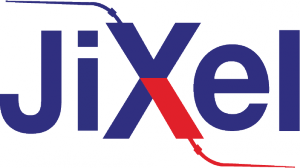
The power of the Jixel platform, the event management system developed by IES Solutions, does not end with Jixel-Radio.
With Jixel, any authority can manage any kind of event, from the small ones to the large-scales ones that require the involvement of several and different actors. Jixel allows the management of events, missions, resources and structures so to have all the tools to face the event. Every action, mission and resource is shown on the interactive map included in the platform, so to help the operators to have a clear picture of what’s happening.
Moreover, every organisation within the platform can share information and instructions, making every actor perfectly aware of the ongoing situation. As an example, a Municipality can share, an information with Fire Fighters, local Civil Protection and local Police, at the same time and with a single click. No need to phone every organisation: Jixel provides an information sharing which is safe, fast and reliable. Furthermore, Jixel can collect information from public alert channels, such as meteorological or geophysical institutes.
As said, the Sannazzaro Municipality activated its Emergency Plan: Jixel, designed to manage civil protection and emergency events, allows the creation, the consultation and the activation of Emergency Plans directly from the platform, without the need of using other tools and saving precious time.
There is not a best channel for the alerting of the population: the solution is using more channels simultaneously, reaching the largest number of citizens. The Jixel suite, through its Jixel-Alerter module, allows the authority to use multiple channels at the same time. The system includes SMS, specific Apps (such as m-Jixel), social media, sirens, banners, variable message signs, email, fax. One message, more channels, all from a single interface.
Resource and event management, population information, data collection, data exchange: only a system capable of all those functions can be regarded as complete. the mana regarded as complete.
To find out all the functionalities of Jixel and Jixel-Radio, visit the websites www.jixel.eu and www.jixel.eu/web/jixel-radio
Photo credits: Corriere della Sera, La Stampa, Twitter



